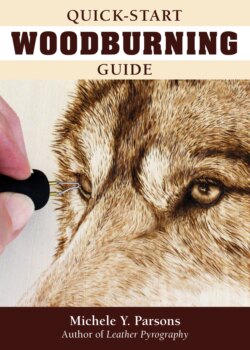Читать книгу Quick-Start Woodburning Guide - Michele Y. Parsons - Страница 6
На сайте Литреса книга снята с продажи.
Safety
ОглавлениеWhen you burn material, it releases fumes into the air. Breathing certain fumes can cause serious health risks. Sometimes the fumes can be irritating to your lungs; other times, fumes can be toxic to your health.
| Suitable Materials to Burn | Dangerous Materials to Burn |
| Natural, raw wood | Wood that has been treated, painted, or sealed |
| Light-colored domestic wood (like basswood, maple, poplar, or ash) | Dark-colored or exotic wood (like walnut, cocobolo, cedar [for some people], African mahogany, mimosa, olive wood, rosewood, milky mangrove, mulga, laburnum, oleander, and yew) |
| Dry, clean wood | Spalted, mildewed, or moldy wood |
| Vegetable-tanned leather | Chrome-tanned or chemically tanned leather |
| Natural cork | Chemically treated cork |
| Natural canvas | Chemically treated canvas |
| Cleaned gourds | Moldy gourds |
| Natural materials | MDF/bonded or man-made boards/ acrylics/plastics |
| Tagua nuts (vegetable ivory) | |
| Paper (like 140 lb. [300g] watercolor paper, hot or cold pressed) |
Only burn natural and untreated items !
Leaning over your work causes the fumes to rise directly into your face. Sit back in your chair. If you cannot see your work well, use magnifying glasses or a slant table or easel.
Sitting back in your chair and using a slanted surface results in fumes rising without getting in your face. It can also prevent overhead lighting from reflecting off your burning, causing a glare.
Use a small fan to blow fumes away from you and your work. Open windows and doors for better air circulation.
Use an activated carbon filter fan next to your work to trap fumes. The fumes should go through the fan immediately when burning for best results.
Another way to avoid breathing the fumes is to build a ventilation system that vents directly to the outdoors. This is a permanent solution that does not allow for carrying your work to a temporary location, such as when you can bring a fan to a pyrography class.
A ventilation system can include several options: a hooded vent located over the burning area, a fan to blow the fumes outdoors, or an activated carbon filter fan to draw the fumes through the filter before they are channeled outdoors.
Set your activated carbon filter fan on blocks to raise it over the edge of your slanted surface (or rotating easel). This will trap the fumes as they roll off the edge of the artwork. Fans with a higher CFM (cubic feet per minute) rating are better at drawing fumes away.
Use a respirator with vapor filters, not dust filters. There are several inexpensive and comfortable half-mask options to choose from.
Tip Check the CFM (cubic feet per minute) rating on the activated carbon filter fan when purchasing. The higher the CFM number, the better the fan will be at removing fumes.
Safety Tip Get into the habit of turning off your woodburner when you are connecting/ reconnecting pens or when you stop burning for a few minutes. If you develop this habit, you will automatically turn off the woodburner and avoid any potential hazards.
